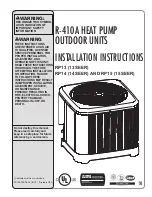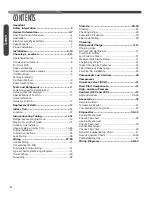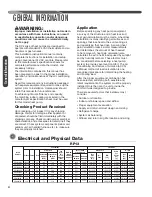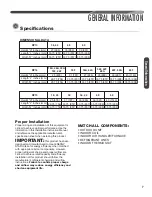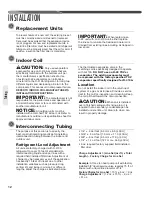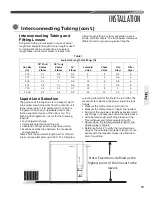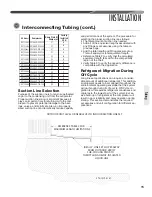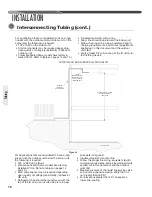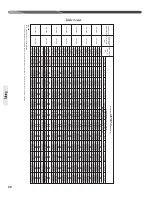
9
Location
INSTALLATION
Choosing a Location (cont.)
For Units With Space
Limitations
In the event that a space limitation exists, we will
permit the following clearances:
Single-Unit Applications: Clearances below 6"
[15.2 cm] will reduce unit capacity and efficiency.
Do not reduce the 60" [152.4 cm] discharge or the
24" [61.0 cm] service clearances.
Multiple-Unit Applications: When multiple
condenser grille sides are aligned, a 6" [15.2
cm] clearance is recommended for 1.5 and 2
ton models and 9" [22.9 cm] for 2.5 ton to 5 ton
models. Two combined clearances below the
minimum will reduce capacity and efficiency. Do
not reduce the 60" [152.4 cm] discharge or 24"
[61.0 cm] service clearances.
Customer Satisfaction Issues
• The heat pump should be located away from the
living, sleeping, and recreational spaces of the
owner and those spaces on adjoining property.
• To prevent noise transmission, the mounting pad
for the outdoor unit should not be connected to
the structure and should be located a sufficient
distance above grade to prevent ground water
from entering the unit.
Unit Mounting
WARNING:
Secure an elevated unit
and its elevating stand in order to prevent tipping.
Failure to do so may result in severe personal
injury or death.
Elevation of Unit
If elevating the heat pump, either on a flat roof or
on a slab, observe the following guidelines.
• If elevating a unit on a flat roof, use 4" x 4"
[10.2 cm x 10.2 cm] or equivalent stringers
positioned to distribute unit weight evenly and
prevent noise and vibration.
• Where snowfall is anticipated, raise the unit
above the base pad to prevent ice buildup and
coil damage. Mount the unit high enough to be
above the average accumulated area snowfall.
See “Ground Snow Depth” chart on page 10 for
representative snow depths.
NOTICE:
Do not block drain openings on
bottom of unit.
• If unit must be elevated because of anticipated
snowfall, secure unit and elevating stand such
that unit and/or stand will not tip over or fall off.
Keep in mind that someone may try to climb on
unit.
Factory-Preferred Tie-Down
Method for High Wind or
Seismic Loads
IMPORTANT:
The manufacturer-
approved/recommended method is a guide to
securing equipment for wind and seismic loads.
Other methods might provide the same result, but
the manufacturer method is the only one endorsed
by the manufacturer for securing equipment where
wind or earthquake damage can occur. Additional
information is available in the PTS (Product
Technical Support) section of the manufacturer’s
Web sites Rheemote.net, MyRheem.com, or
MyRuud.com and can be found as a listing under
each outdoor model. If you do not have access to
this site, your distributor can offer assistance.
SERVICE PANELS/
INLET CONNECTIONS
/ HIGH & LOW
VOLTAGE ACCESS
ALLOW 24” [610 mm] OF
CLEARANCE
ALLOW 60” [1524 mm]
OF CLEARANCE
AIR INLET LOUVERS ALLOW
6” [152 mm] Min. OF
CLEARANCE ALL SIDES
12” [305 mm] RECOMMENDED
ST-A1226-04-00
6" MIN. (152 mm) FOR 1.5 & 2 TON
9" MIN. (229 mm) FOR 2.5-5 TON
24" MIN. (610 mm)
ST-A1226-03-00
ELEVATE ABOVE
ANTICIPATE HIGH
SNOW FALL
DO NOT BLOCK
OPENINGS
IN BASE PAN
BASE PAD
(CONCRETE OR OTHER SUITABLE
MATERIAL)
Summary of Contents for RP13
Page 50: ...50 FOR SINGLE PHASE WITH PSC FAN MOTORS WIRING DIAGRAMS Wiring Diagrams...
Page 51: ...51 Wiring Diagrams WIRING DIAGRAMS 3 PHASE 208 230V MODELS...
Page 52: ...52 Wiring Diagrams WIRING DIAGRAMS FOR 3 PHASE 460 575V...
Page 54: ...54...
Page 55: ...55...
Page 56: ...56 CM 0815...

